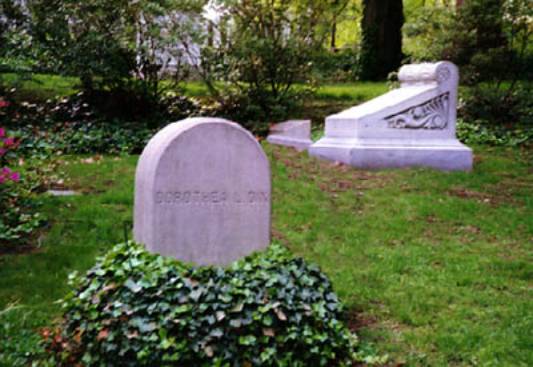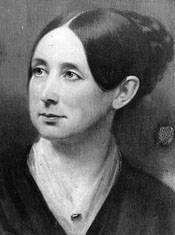Brief
Dorothea Dix (1802-87), in
her early career a teacher and author of children’s books, was, in her
unique and international role as an advocate for improvements in the
treatment of patients suffering from mental and emotional disorders. She
is the most visible humanitarian reformer of the 19th century.
During the Civil War she served as Superintendent of United States Army
Nurses.
EARLY LIFE
Dorothea Lynde Dix was born on April 4, 1802 in the town of Hampden, Maine. She was the oldest child of three born to Joseph Dix and Mary Bigelow Dix. Her father was an itinerant Methodist preacher. Her family life can be described as abusive and nonexistent. Her mother was not in good mental health and her father was an abusive alcoholic. Once the family was in Worcester they had two more children, Joseph and Charles. Almost immediately Dorothea began to care for her smaller brothers. Later in life she commented, “I never knew childhood”. This was mainly because of her parents’ unstable household, and her role of taking over the raising of her brothers. Many times when the fighting in her household got out of control she would take refuge at her grandmother’s house, from her father’s side, in Boston.
Even though her household wasn’t the best she learned many things
from her father that would influence many of her choices in life. When she
was young he taught her how to read and write, thus when she entered
school she was way ahead of everyone else. This developed a passion for
reading and teaching, as she taught her brothers how to read as well. Soon
after their move to Vermont her parents moved to Worcester, Massachusetts.
At this time her mother was suffering from acute, incurable headaches and
her father was drinking heavily. It was decided that at this time that her
parents were no longer capable of caring for their three children. Madame
Dix, Dorothea’s grandmother, decided to take the three children to live
at the Dix Mansion in Boston. Madame Dix sent her son and his wife off to
live with relatives. At this time, Dorothea was twelve and had already
been accustomed to caring for her brothers, which is something that
continued as she lived with her seventy-year old grandmother.
Life at the Dix Mansion was extremely different than Dorothea was
accustomed to. Her grandmother was wealthy and demanded that Dorothea act
and has interests of a wealthy girl. Her grandmother hired a dance
instructor and a seamstress to cater to Dorothea’s personal needs.
However, Dorothea did not want any of these things. At one point her
grandmother punished her severely for trying to give food and her new
clothes to the beggar children who were standing at the front gate. At the
age of fourteen, Madame Dix requested that her sister, who lived in
Worcester, take care of Dorothea for a “while” and turn into a
“lady.” Mrs. Duncan, Madame Dix’s sister, agreed to this since she
was always very fond of Dorothea. Once she arrived at her great aunt’s
house Dorothea immediately took on the role of a “young lady” so she
could return to her brothers. However, she was to stay with her aunt for
nearly four years.
DIX’S MIDDLE LIFE
By
1821, she was again residing with her grandmother in Boston. There she
opened a private school, which was opened to young girls. She ran a free
evening school for poor children, one of the first in the nation. She
wrote a number of books for children and parents. Her best known book, Conversations
on Common Things, published in 1824 and much reprinted, was designed
to help parents answer kid’s questions such as: “ Why do we call this
day Monday? What is tin? Why do we call this month January? Does cinnamon
grow on trees?” The
answers given demonstrated Dix’s extensive knowledge of the natural
world. She also published American Moral Tales for Young Persons,
1829, and Meditations for Private Hours, 1828.
She received little formal education, and her appetite for
knowledge was insatiable. She attended public lectures, read widely, and
made a point of keeping company with knowledgeable people. She studied
literature, history, and the natural sciences with a special emphasis on
botany and astronomy. As a teacher she did her intellectual homework
before embarking on any project, a practice she continued while she was a
reformer in her later work.
By the early 1920’s Dix had found her religious home among Unitarians.
She appreciated the Unitarians emphasis on goodness of God, purity of all
society. A close friend of William Ellery Channing, the famous pastor of
the Federal Street Church in Boston, she served time to time as governess
of the Channing children and sometimes accompanied the family on
vacations. She felt nearest to God when she was involved in specific
actions that resulted in measurable good effects.
Anne Heath became a lifelong friend and confidant. Heath like Dix, would
never marry, but unlike Dix, had grown up in a stable extended family and
found contentment in domestic activities. They were friends for over 50
years until Heath’s death in 1878. Dix’s inner world was filled with
appreciation for poetry, literature, history, and nature, but married by
loneliness, alienation, and self-deprecation.
Dix’s
teaching career got interrupted time to time by a recurring and severe
upper respiratory ailment aggravated by a work schedule that afforded too
little sleep. In 1836 she was forced to take an extended rest. With a
letter of introduction by Channing Dix moved to Liverpool, England where
she stayed in the home of a Unitarian philanthropist, William Rathbone.
They took a great like to Dorothea and treated her with more affection
than she had ever had with her own family. She remained with them for a
year, until she gradually gained strength.
In 1837, following the death of her grandmother and her mother, Dix
returned to the United States. Still not strong enough to resume teaching,
she supported herself during a period of recuperation and limited travel
funds from the Dix estate and her savings and royalties from the sale of
her books.
HER INFLUENCE ON TREATMENT IN MENTAL
INSTITUTIONS AND JAILS
In March 1841 Dorothea entered the East Cambridge Jail. She had
volunteered to teach women inmate’s Sunday school class.
When she entered the jail she witnessed such horrible things that
her life was changed forever. Within the walls of this jail she saw
prostitutes, drunks, criminals, retarded individuals, and the mentally ill
all housed together in unheated, unfurnished, and foul-smelling quarters.
When she asked why the jails were in these conditions their answer was “
the insane do not feel heat or cold.”
She took the matter to court and finally won. Dorothea then proceeded to
visit jails and almshouses, where the mentally ill were housed, in other
parts of Boston. Soon her investigations extended over the entire state of
Massachusetts. She made careful and extended notes as she visited with
jailors, caretakers, and townspeople. She put all this information
together, organized it, and took it to the Massachusetts legislature. Her
timed presentation of her findings completely won over the legislative
board because her conviction was so powerful. After a heated debate over
the topic the material won legislative support and the funds were set
aside for the expansion of Worcester State Hospital.
Dorothea’s views about the treatment of the mentally ill were radical at
the time. The belief back then was that the insane would never be cured,
and living within their dreadful conditions of the inmates, showed people
that mental illness wasn’t all incurable. She stated that, “ some may
say these things cannot be remedied, these furious maniacs are not to be
raised from these base conditions. I know they are …I could give many
examples. One such is a young woman who was for years ‘a raging
maniac’ chained in a cage and whipped to control her acts and words. She
was helped by a husband and wife who agreed to take care of her in their
home, and slowly she recovered her senses.”
Later
she started to travel to other states and proceeded to do the same
process: extensive travel to jails and almshouses in a state, careful
descriptions of conditions in jails and almshouses, and preparation of a
document comparable to the one which proved successful in Massachusetts.
Although her health was poor, she managed to cover every state on the east
side of the Mississippi River. In all she played a major role in founding
32 mental hospitals, 15 schools for the feeble minded, a school for the
blind, and numerous training facilities for nurses. She also was
instrumental in setting up libraries in prisons, mental hospitals, and
other institutions.
GOING AFTER DREAMS
When she got to Europe she had no time to rest before she began her process of inspecting jails and almshouses there as well. She traveled to England, Scotland, France, Austria, Italy, Greece, Turkey, Russia, Sweden, Denmark, Holland, Belgium, and Germany. She made an effective change in the way Europeans treat mentally ill and inmates during 1854 to 1856.
HELPING IN THE ARMY
Dix finally retired at age 79. Depressed by accommodations and programs for the insane, she did not talk about her work; nor would she cooperate with those who inquired about her life and career. She died in 1887, and was buried in Mount Auburn Cemetery in Cambridge, Massachusetts.

Dick Weeks
Dorothea Dix 1802- 1887
http://www.civilwarhome.com/dixbio.htm
(5/9/05)
| Dictionary of Unitarian and universalist
Dorothea Dix Biography http://www.uua.org/uuhs/duub/articles/dorotheadix.html (5/9/05) |
| Jenn Bumb
Dorothea Dix http://www.webster.edu/~woolflm/dorotheadix.html (5/5/05) |


